�
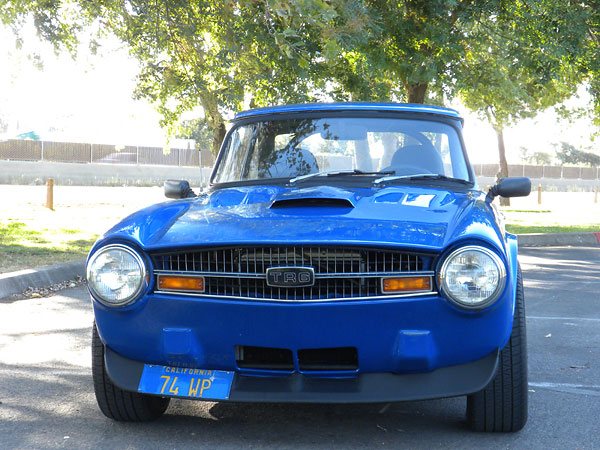
�
Ken Percival's 1972 TR6 / Ford 289 V8 Conversion
� as published in BritishV8 Magazine, Volume XVII Issue 2, December 2009�� Owner: Ken Percival
� Phone: 916-368-1965
� City: Sacramento, California
� Model: 1972 Triumph TR6
� Engine: 1965 Ford 289
� Conversion performed by: Ken Percival and friends
�
| Engine: | �1965 Ford 289 "H.P." block and steel billet crank. The top end has been converted to �
"4V" specification (with hydraulic lifters.) The engine has a performance camshaft, �
but it was installed by the engine's previous owner, and its specs are unknown.�
Edelbrock Performer intake manifold. Holley 600cfm double-pumper carburetor. �
K&N X-Stream filter top. Ford distributor with Crane pick-up and rev limiter. �
Aluminum water pump. Front-sump oil pan. The motor mount assembly is from a kit that's�
made for putting a Ford 5.0 V8 into a 1953 Ford truck (see below).�
Canton oil pan, windage tray and racing pick-up. | �
| Cooling: | �modified stock TR6 radiator, with dual intake and exhaust ports and a 4-row core. �
Flexalite 16" electric fan. | �
| Exhaust: | �1965 Mustang HP iron exhaust manifolds, into a custom 2" O.D. exhaust system with �
dual inlet, dual outlet Dynamax muffler. (The sound is a little more "European".) | �
| Transmission: | �Borg Warner T5 5-speed (circa 1993) with 0.63:1 fifth gear. Cable operated clutch. �
The TR6 clutch pedal was used without modification. Ford Racing lightweight flywheel. �
Custom shortened driveshaft. | �
| Rear End: | �TR6 with Quaife limited slip differential and 3.69.1 ring and pinion set. �
Stock TR6 axles. | �
| Chassis: | �front crossmember cut 2.5" for engine clearance, and strengthened by chambering. �
A 1" x 1.5" channel was added in front, and a second crossmember was added with �
motor mounts on in. Lower A-arm suspension mounts and suspension towers were �
tied together with a long piece of 1/8" steel. A roll hoop was also added. | �
| Front Suspension: | �competition springs that were cut down 1". Spax telescoping shocks. �
Modified lower A-arms with spacer and shims to provide about 2.2 degrees of �
negative camber and about 4.2 degrees of positive castor.�
Derling bushings. | �
| Rear Suspension: | �competition springs and tube shock conversion. (A large plate was added �
to the body at the top mounting point.) | �
| Brakes: | �normal aftermarket upgrades from Moss Motors. | �
| Wheels/Tires: | �stock TR6 wheels. Ohtsu 205/65HR15 front tires, 215/70HR15 rear tires. | �
| Body: | �entirely custom-made, front-hinged, fiberglass front clip.�
German-market Triumph TR6 turn signal lamps have been mounted in the grille.�
Mazda Miata seats. | �
| Instruments: | �Autogauge tachometer. New temperature gauge and voltmeter. | �
| Weight: | �only 2087 pounds. | �
| Performance: | �Calvin Grannis reports that the car will easily smoke its tires in first �
or second gear, and that third gear is a total hoot. �
He also reports that the car handles especially well, apparently largely on�
account of the negative camber front suspension set-up. | �
| Completed: | �May 15, 2009. (Driven approximately 3000 miles as of September 2009.) | �
| Comments: | �This car was autocrossed when it had the original TR6 engine in it, and I won first �
place over a high dollar Jag. I beat the Jag by 4 tenths of a second. I had the �
negative camber in front and this helped the handling a lot. The person that owned �
the Jag was pretty upset at the time, so on a straight length of road he showed me �
who was boss.�
� The Ford 289 was originally installed in my MGB (with a C4 transmission and a 9" rear).� The MGB was built in about 1996, and was driven until it was wrecked in September 2007. � I already owned the TR6, and decided to transfer the V8 to the Triumph which took � about 2 months for the basic conversion plus time for bodywork, paint, electrical, etc.� � I've owned the TR6 since 1981. In 1989, I hit a patch of black ice and crashed. � I lucked into a set of fiberglass fenders and a hood. I bought them used but they � had never been installed, and in total they cost me less than a new steel hood. � Instead of simply installing the fiberglass fenders and hood in the conventional � way, I tied them all together into a one piece front clip and installed them with � a custom front-tilt mechanism. The hood vents were installed in about 1994. I � found that air was packing-in under the hood and causing it to bulge at speed. � The Ford Mustang style hood scoop was installed when I did the V8 conversion. � � This car continues to be an ongoing project. I plan to add 16" wheels and � stickier tires soon. Aluminum heads and a new camshaft are also planned. Quite � a lot of work has already gone into shaving weight, and weight savings continues � to be a priority.� � The philosophy of this build was "keep it simple". A few fundamental decisions� were made early on with a view to keeping costs down: the engine was placed very � carefully in the chassis, the throttle and clutch pedals were kept basically � stock, a cable operated clutch was designed instead of a hydraulic clutch, � and the stock radiator was used. All of these decisions have worked out well.� The engine placement also facilitated use of Mustang HP manifolds, which� are quieter and transfer less heat into the passenger area. � | �
�
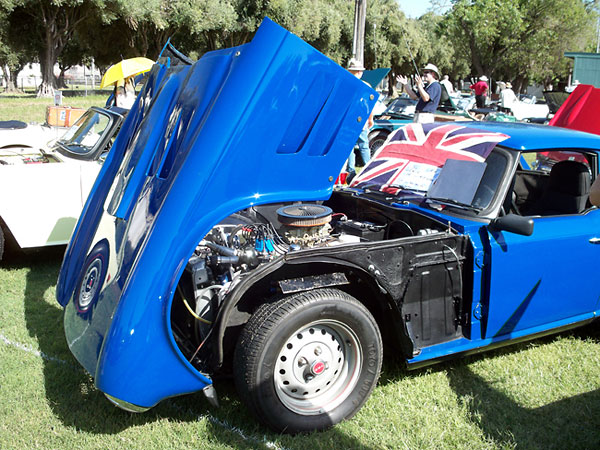
�
Front hinged hood!�
�
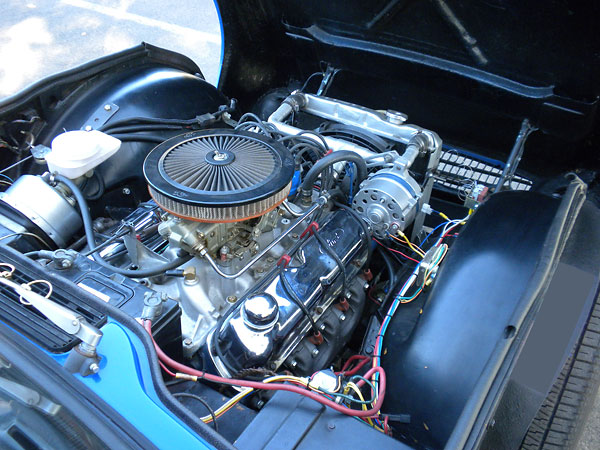
�
1965 Ford 289
�
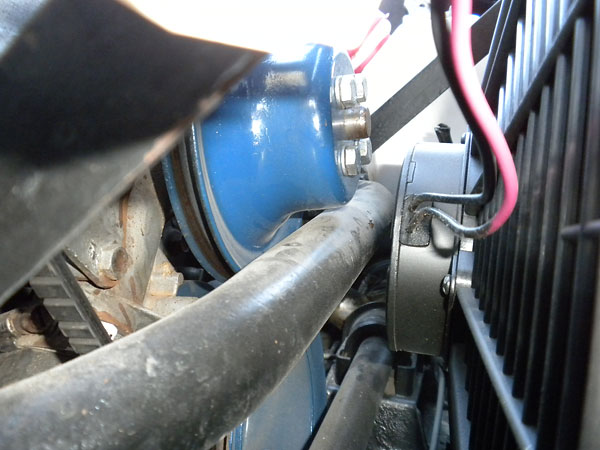
�
This horizontal tube is the stock Triumph TR6 upper suspension support (unmodified).
�
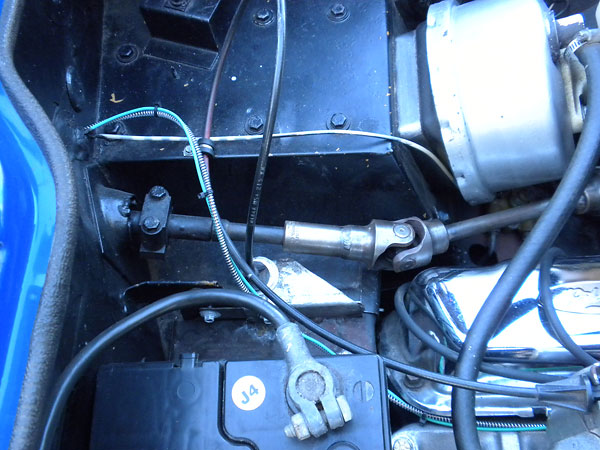
�
Borgeson universal joints (2).
�
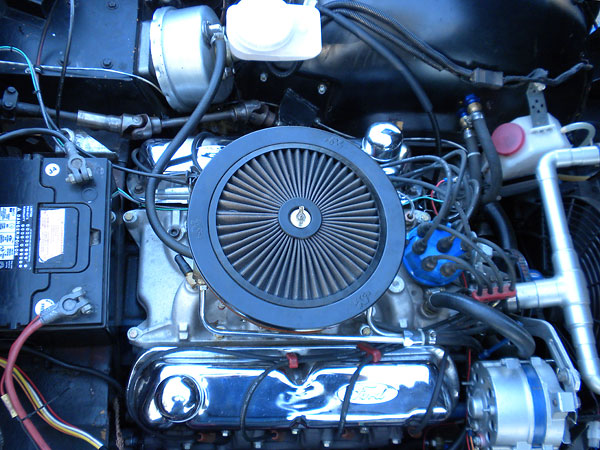
�
Ken strongly recommends the K&N X-Stream filter top. A Crane pick-up has been installed in the distributor,
�
but after using it, Ken would recommend installing a Pertronix.
�
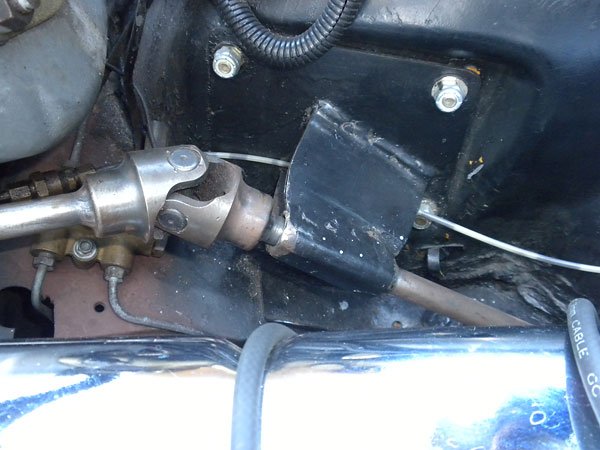
�
�
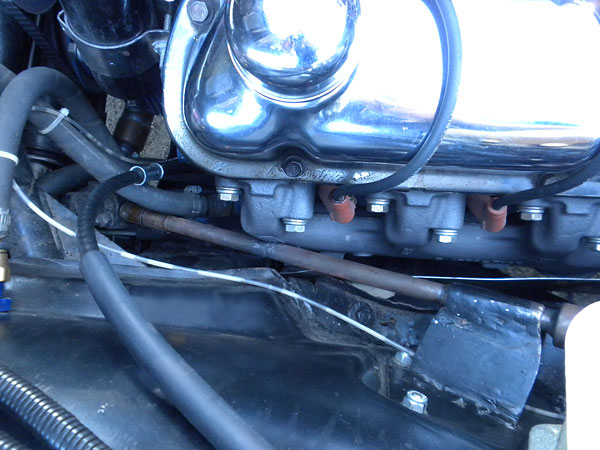
�
The clutch release cable can be seen in the foreground.
�
�
Enjoying this article? Our magazine is funded through the generous support of readers like you!
�
To contribute to our operating budget, please click here and follow the instructions.
�
(Suggested contribution is twenty bucks per year. Feel free to give more!)�
�
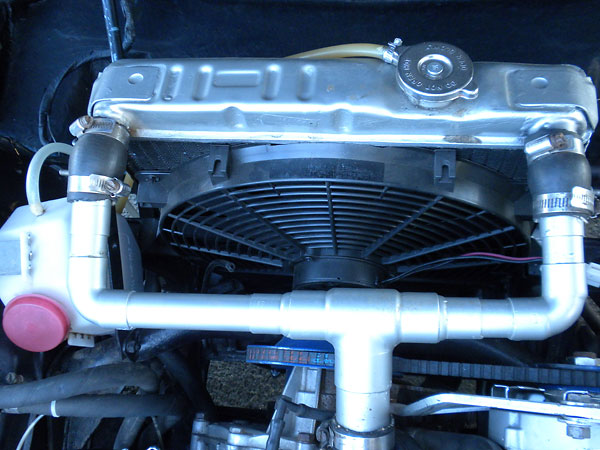
�
Stock TR6 radiator: since the tanks are relatively small, Ken has added a second one inch intake port. The
�
ports on the engine are 1.5" diameter. A similar approach was used for both top and bottom radiator tanks.
�
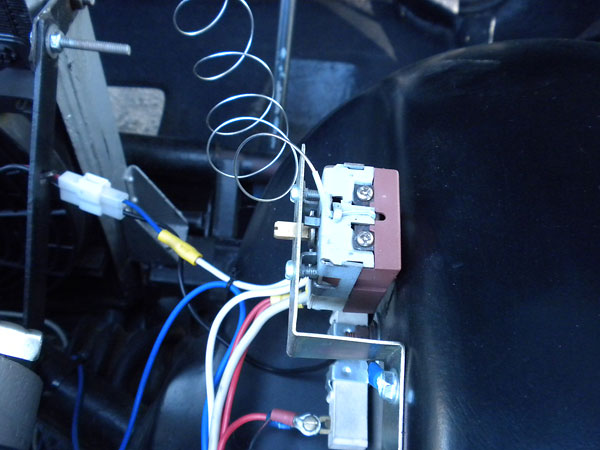
�
Cooling fan thermostat.
�
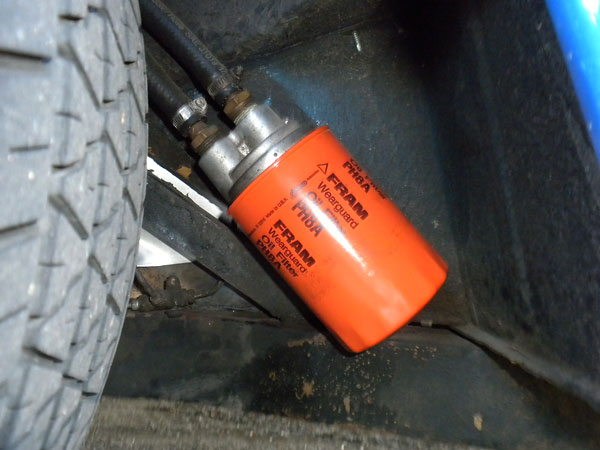
�
Remote oil filter installation.
�
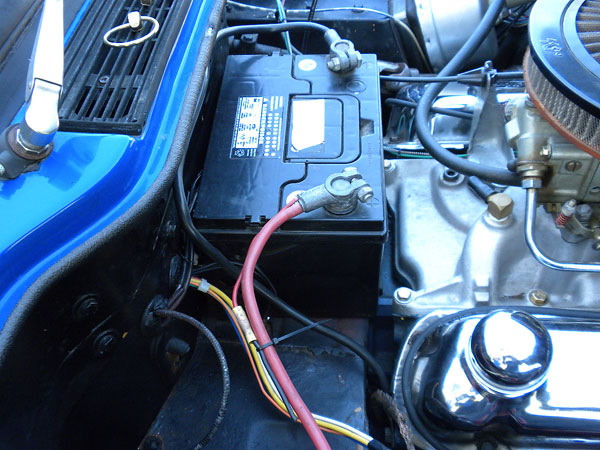
�
Battery remains in the stock position, on an unmodified battery shelf.
�
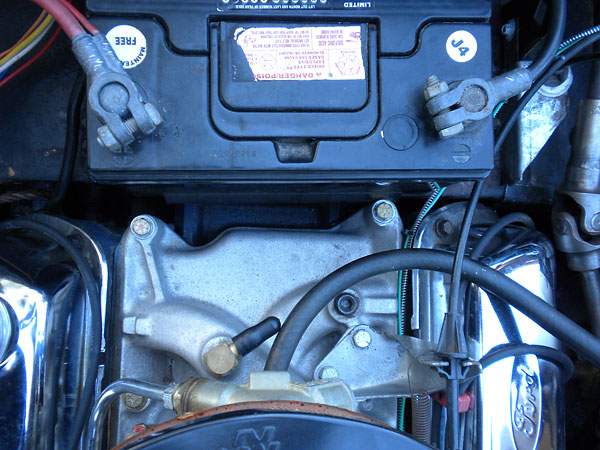
�
Clearance between engine and battery tray.
�
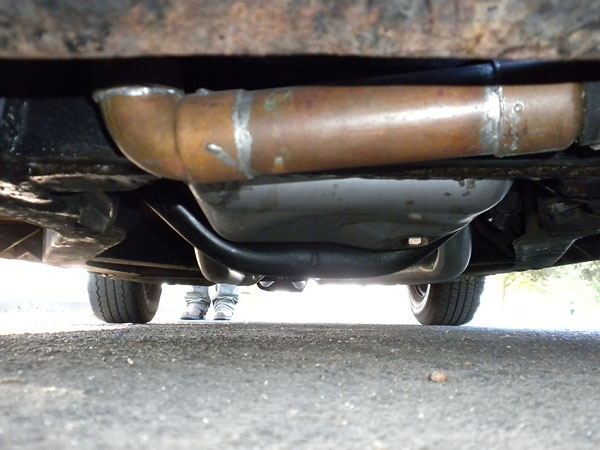
�
It's impossible to see here, but this copper adapter converts from a single 1.5" radiator port
�
on the engine, to two 1" diameter ports on the bottom radiator tank.
�
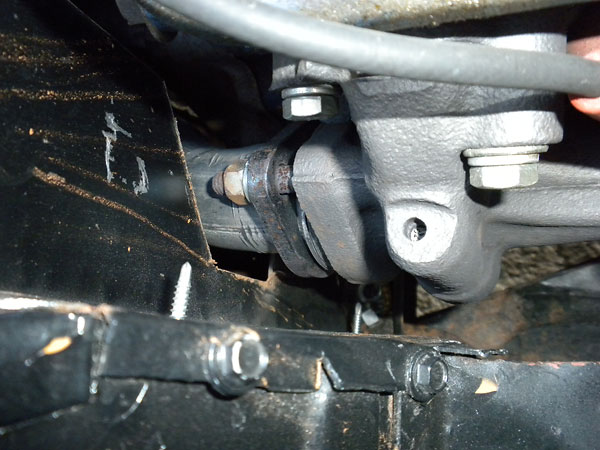
�
Couplings on the iron exhaust manifolds.
�
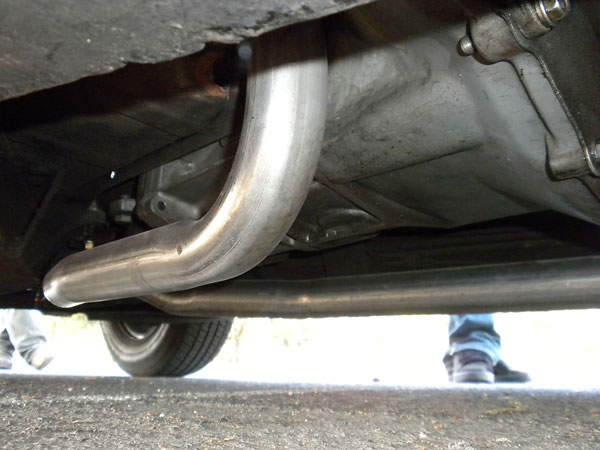
�
Exhaust pipes from the manifolds rearward.
�
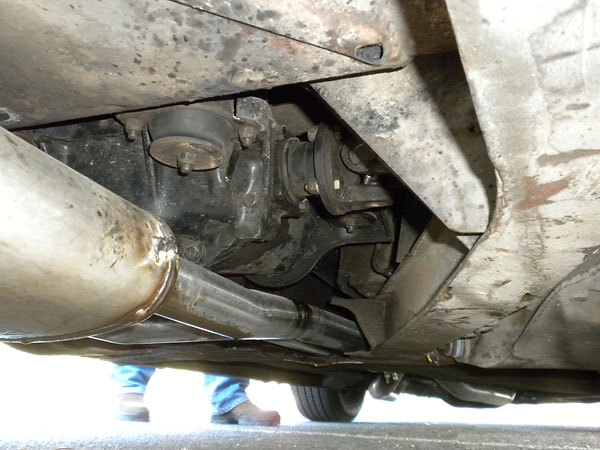
�
Exhaust pipe routing.
�
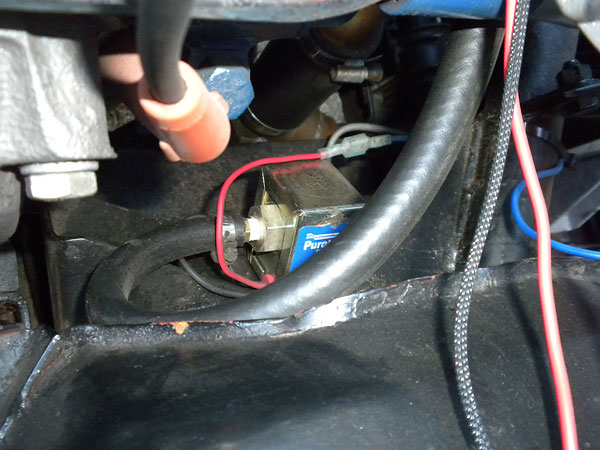
�
Purolater fuel pump.
�
�
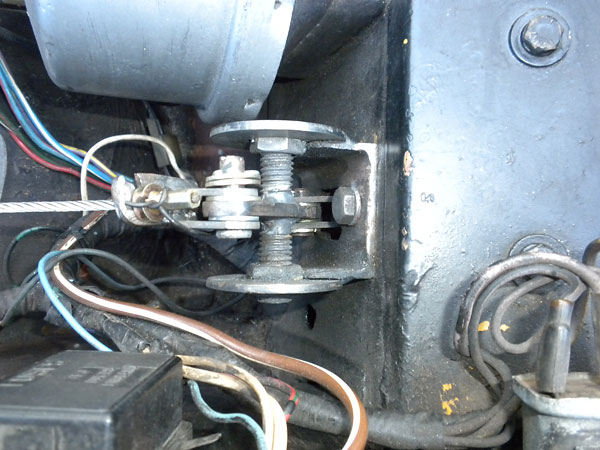
�
Clutch cable bracket/bellcrank on firewall, bolts through existing bolt holes.
�
The crank levers only need to be about 1.5" long.
�
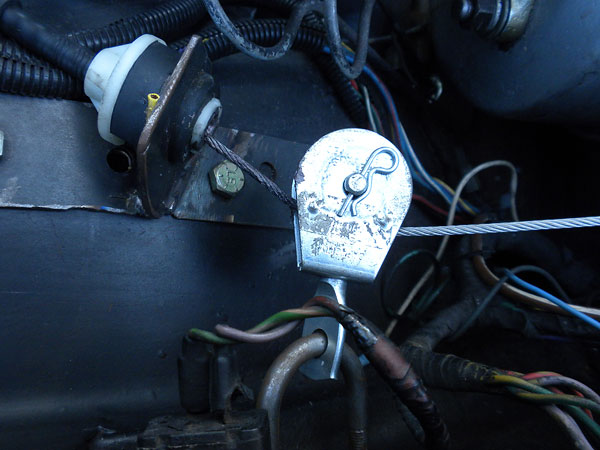
�
The clutch release cable core is actually a modified emergency brake cable, which is quite robust.
�
The cable needs to have crimped-on terminals at the right length. Shops do that locally for about $30.
�
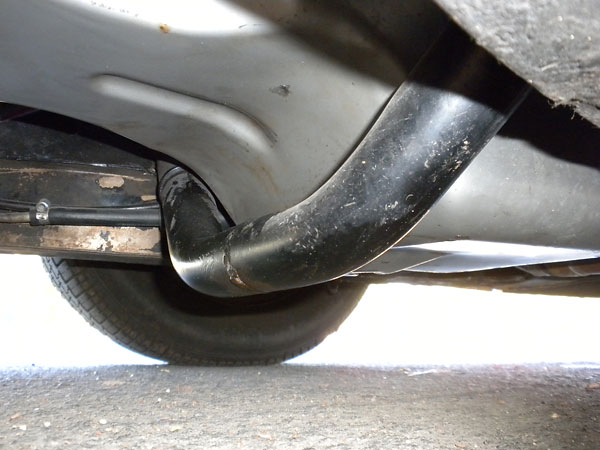
�
The crossmember shown here is the lowest point on the chassis. It's part of the motor mount
�
assembly from a kit that's made for putting a Ford 5.0 V8 into a 1953 Ford truck, and it's
�
welded to the Triumph frame. The actual rubber motor mounts are standard Ford parts.
�
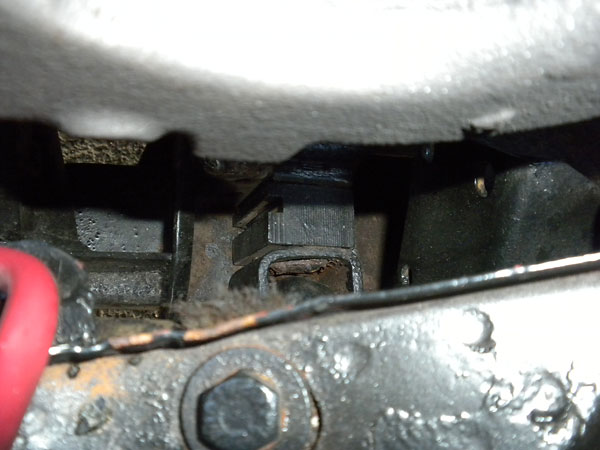
�
Spacer blocks provide negative camber.
�
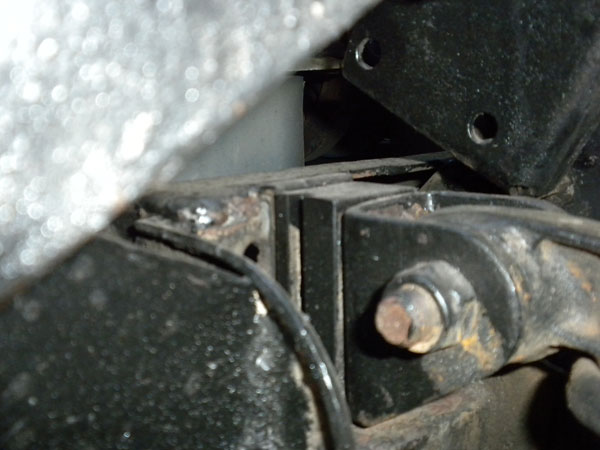
�
(The mounting points of the lower control arms have been spaced away from the frame.)
�
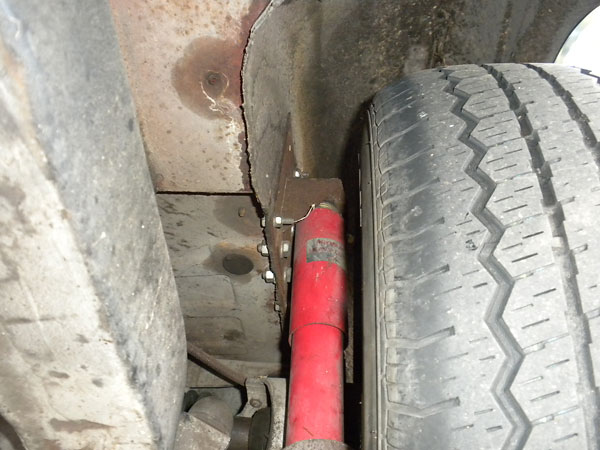
�
Rear tube shock conversion.
�
Customized TR6 Body:
��
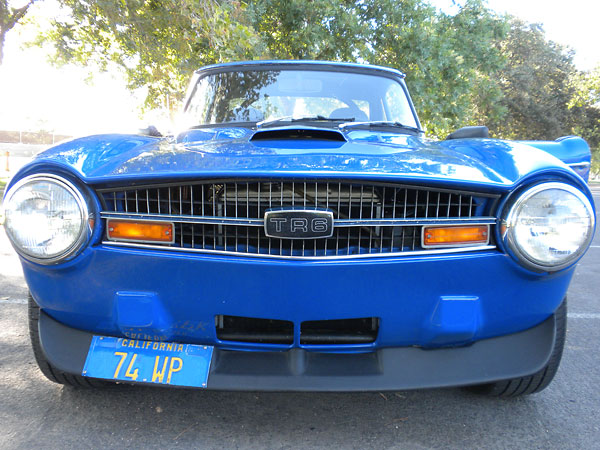
�
Removed front bumper.
�
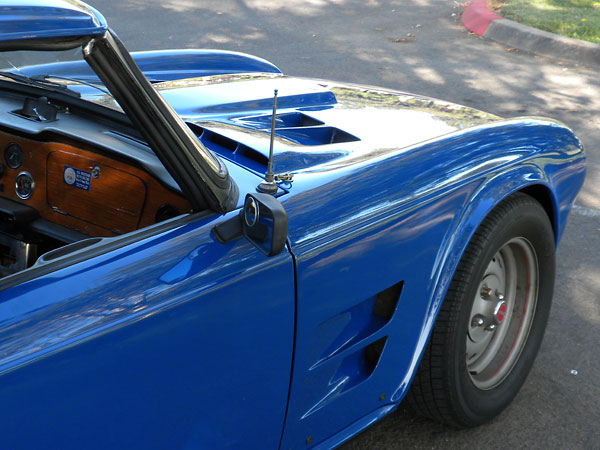
�
Vented hood.
�
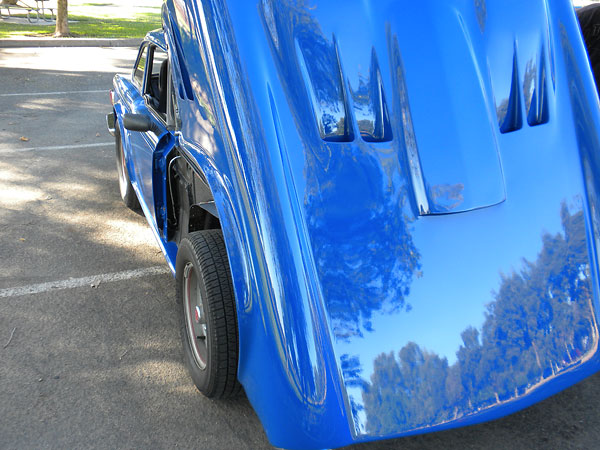
�
Ford Mustang style hood scoop.
�
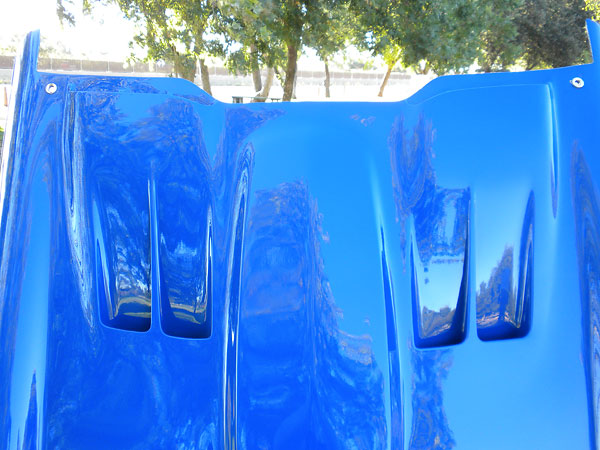
�
�
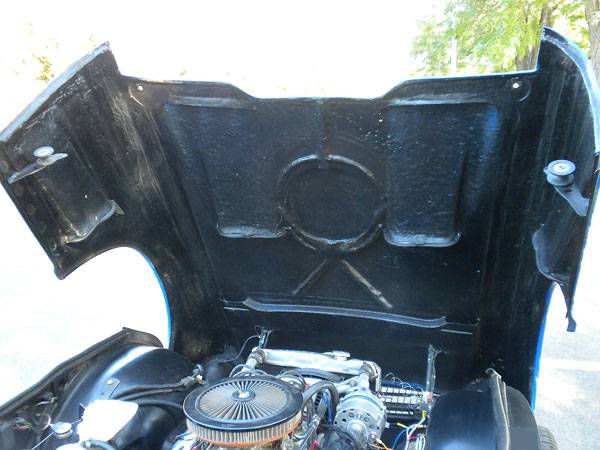
�
Instead of installing fenders and hood the conventional way, I created a one piece front clip...
�
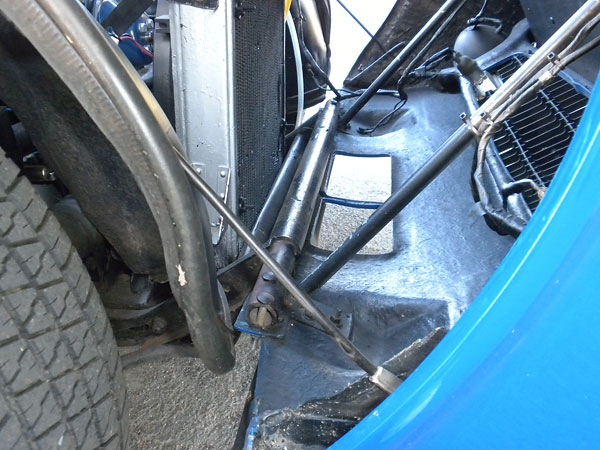
�
...and installed it with a hinge at the front.
�
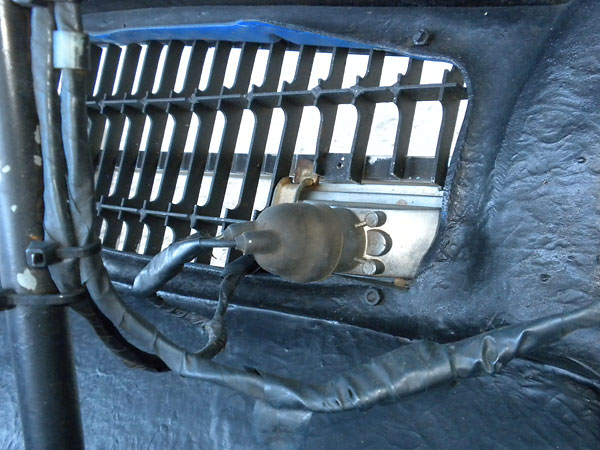
�
German (Merkur?) turn signal lamps have been mounted in the grille.
�
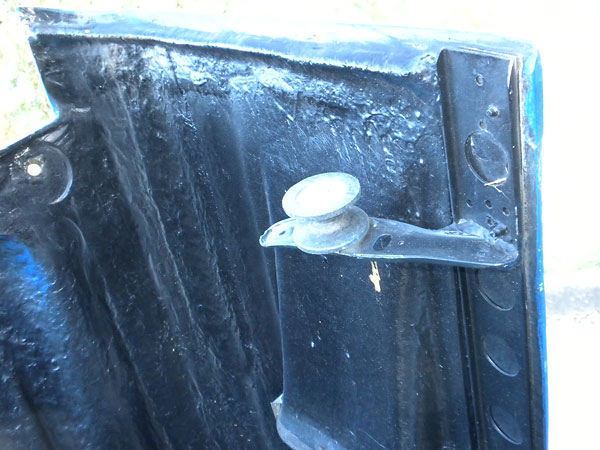
�
Hood latch pin.
�
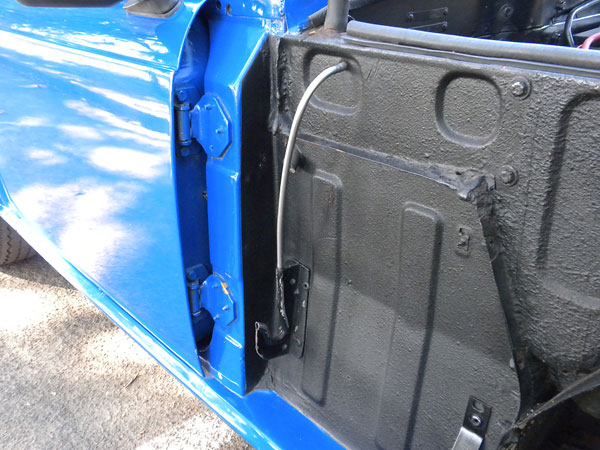
�
The roller and clip hood alignment parts are from BMW 2002. Metal guides have been added above the clips.
�
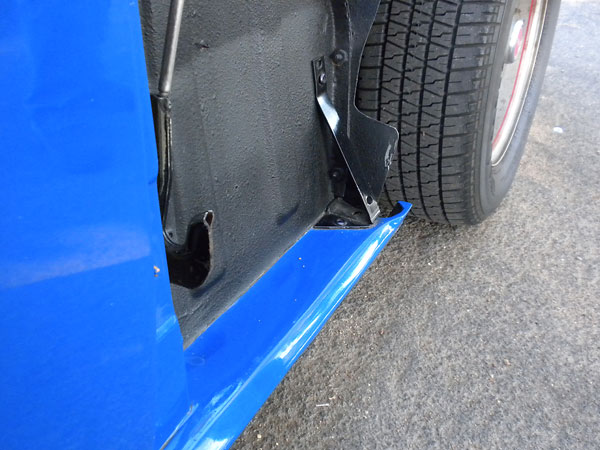
�
�
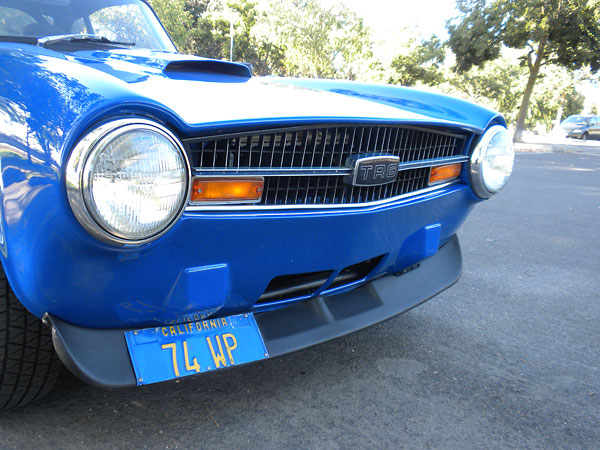
�
Air dam.
�
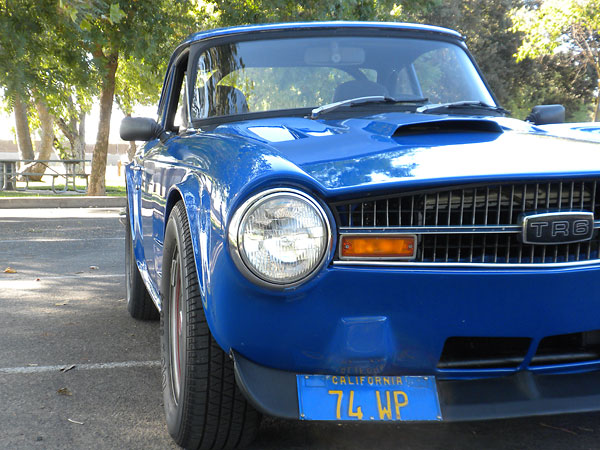
�
In this photo you can percieve the negative camber front suspension alignment.
�
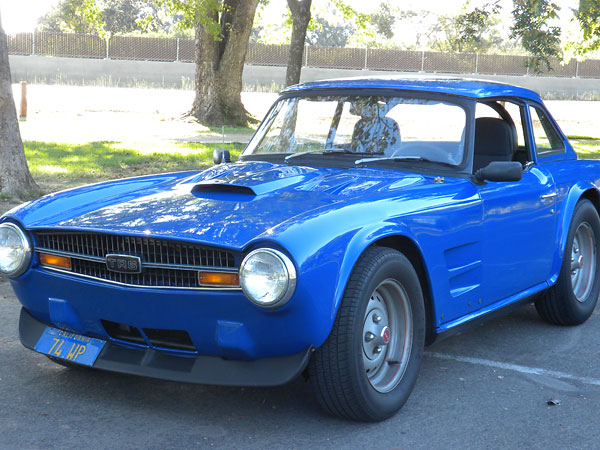
�
Stock Triumph TR6 wheels.
�
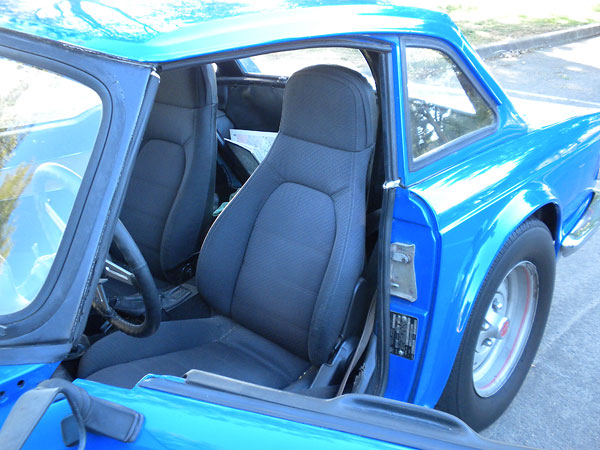
�
Mazda Miata seats.
�
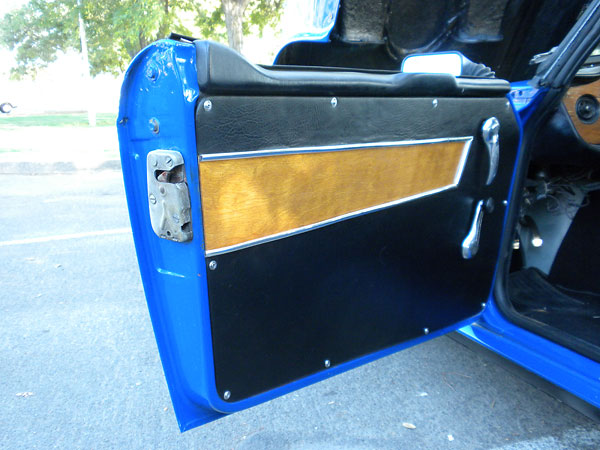
�
Door trim panel.
�
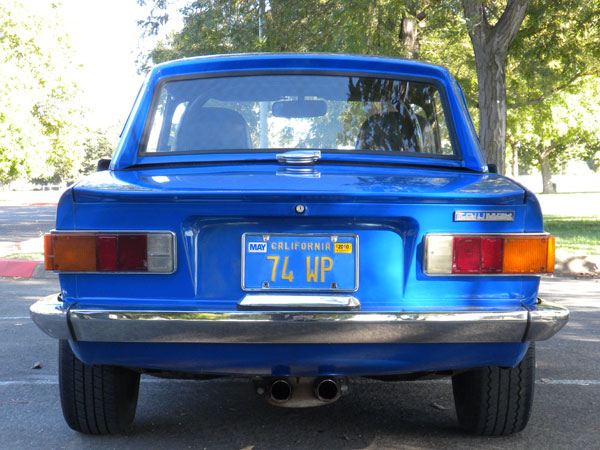
�
Subtle dual exhaust tips.
�
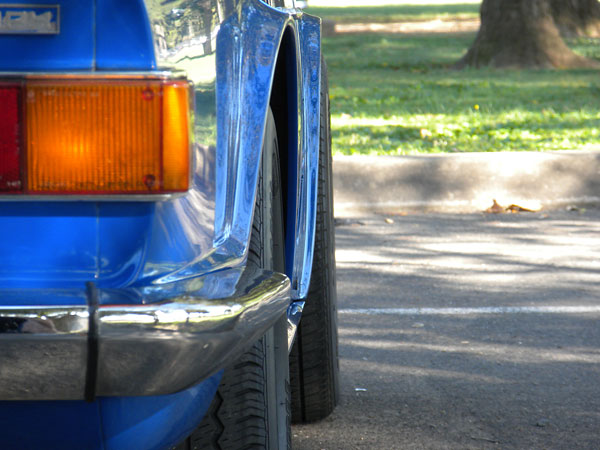
�
Stock Triumph TR6 fender flares.
�
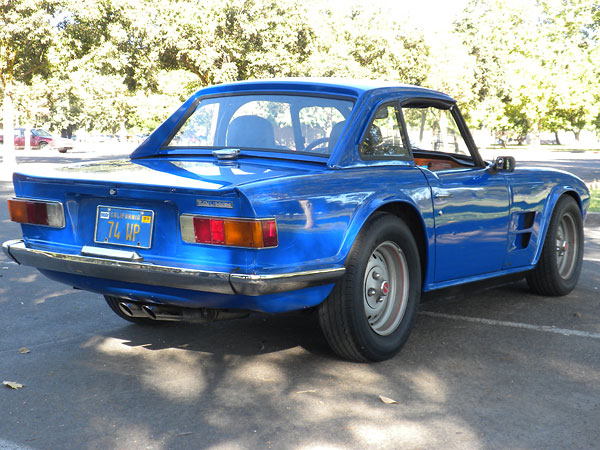
�
Chrome trim has been removed from this Triumph TR6 factory hardtop.
�
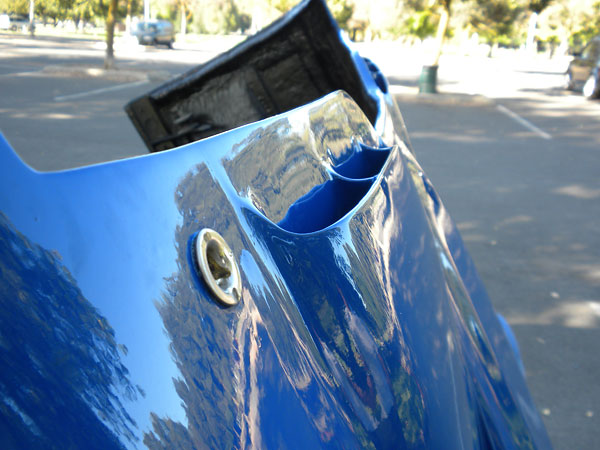
�
Hood pins provide peace of mind.
�
�
The photos shown here are were taken by Calvin Grannis for exclusive use by BritishV8 Magazine.
�
Copyright 2009. All rights reserved. �

